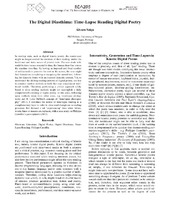| dc.description.abstract | In moving texts, such as digital kinetic poetry, the reader-user might no longer control the duration of their reading, unlike the traditional and static nature of printed texts. The user deals with readable time versus executable time, the human time-line versus the machine time-line. By having an imposed and fixed number of milliseconds to perceive the text on the screen, the user might find themselves completing or imagining the unread text, following the dynamic forms with an imposed dynamic content. Yet, to understand the shifting reading patterns of digital poems, one has to consider another methods or tools that may complement traditional models. Therefore, performing a critical approach solely based in close reading methods might not accomplish a fully comprehensible reading of digital poetry. In this sense, following upon methods taken from other areas, e.g. time-lapse photography and R. Luke DuBois’s concept of “time-lapse phonography” (2011), I introduce the notion of time-lapse reading as a complementary layer in order to close read disruptions in reading processes that demand a set ‘experiencing’ time when letters, words, lines or stanzas are replaced, with a case study on Philippe Castellin’s 'çacocophonie' (2013). | en_US |
